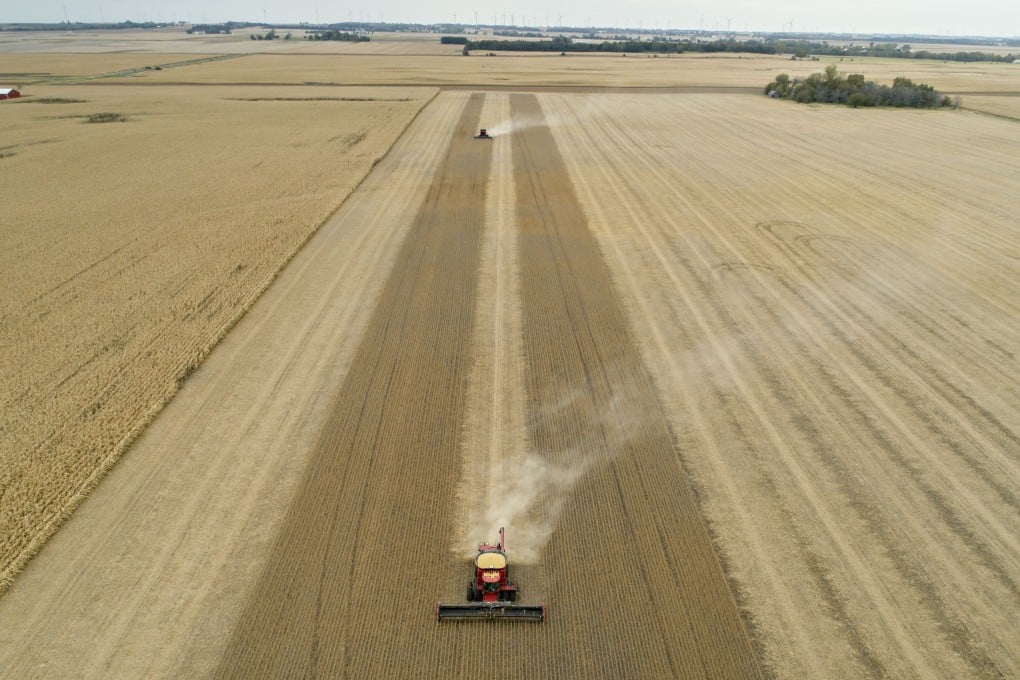American Farmers Battle to Revive Soybean Exports to China
American Farmers Battle to Revive Soybean Exports to China
By
Junia Wells
Last updated:
November 12, 2025
First Published:
November 12, 2025

Photo: South China Morning Post
A fragile recovery amid ongoing tensions
After years of bruising tariffs and trade disruptions, American soybean farmers are once again turning to China — their largest historical buyer — in hopes of restoring lost momentum. Optimism has resurfaced following a recent meeting between former President Donald Trump and Chinese leader Xi Jinping, where the two sides discussed partial tariff rollbacks and renewed agricultural purchases.
Yet, the relief has been limited. While China removed some retaliatory duties on U.S. farm products, it continues to enforce a 13% tariff on American soybeans, a significant barrier for U.S. growers competing with lower-cost producers like Brazil and Argentina.
The front lines of the trade war
For Illinois farmer Scott Gaffner, the struggle is personal. His family’s farm, which typically sends 40% of its soybean exports to China, has seen that figure drop to zero this year. At the China International Import Expo (CIIE) in Shanghai, Gaffner joined a U.S. delegation aiming to reestablish trust and trade flows with Chinese buyers.
“We want to make sure that our soybeans are getting exported to China because it’s a very important market to us,” said Gaffner, a representative of the U.S. Soybean Export Council (USSEC). “We’re here to rebuild relationships that have been damaged by tariffs and uncertainty.”
Before the trade war erupted in 2018, U.S. soybean exports to China averaged over $14 billion annually, with China purchasing nearly two-thirds of all American soybean shipments. But by 2019, U.S. soybean sales to China had plunged by nearly 75%, leaving many farmers with unsold crops and declining income.
Beijing’s cautious approach
According to a White House briefing, China has pledged to buy 12 million metric tons of soybeans before the end of this year and 25 million metric tons annually over the next three years. While these commitments represent progress, they still fall short of pre-trade-war levels, when China imported around 27 million metric tons of U.S. soybeans in 2024 alone.
China has not officially confirmed the new purchase commitments. Analysts suggest Beijing is deliberately diversifying its suppliers to reduce dependency on U.S. crops, with Brazil now supplying nearly 70% of China’s soybean imports, up from less than 50% before the trade conflict.
Farmers adapt and persist
The prolonged uncertainty has forced many American farmers to alter their operations. Instead of exporting immediately after harvest, some are storing soybeans in silos, waiting for prices or trade conditions to improve.
“Normally, we’d load them straight onto barges bound for China,” Gaffner said. “Now, they sit in our bins, waiting. That’s not sustainable for long.”
Despite the challenges, Gaffner remains hopeful. During his trip to Shanghai, his farm secured a small shipment sale — a modest but symbolic step forward. “We like no trade war,” he said. “It levels the playing field. We just want to do business.”
Outlook: cautious optimism
Jim Sutter, CEO of the USSEC, echoed that sentiment. “We’d like to have a continuation of smooth sailing,” he told reporters at the expo. “But these are two major global powers — there are always going to be issues.”
The American Chamber of Commerce in Shanghai noted that while U.S.–China relations have stabilized recently, “structural differences remain,” and agricultural exports will continue to be shaped by political decisions as much as by market demand.
For now, American farmers are betting that diplomacy and persistence can reopen one of the world’s most valuable agricultural trade routes — a path that has long linked the fields of the Midwest with the ports of Shanghai and Guangzhou.
As Gaffner put it: “We’ve weathered tough seasons before. This one’s just global.”
Popular articles
Subscribe to unlock premium content
The Rise of Silent Walking Tours in Historic Cities

The Rise of Ultra-Niche Cooking Classes Focused on Historical or Regional Recipes

The Rise of One-Person Dining Experiences for Ultra-Introverts in Major Cities

The Rise of Silent Walking Tours in Historic Cities

The Rise of Ultra-Niche Cooking Classes Focused on Historical or Regional Recipes

The Rise of Silent Walking Tours in Historic Cities









